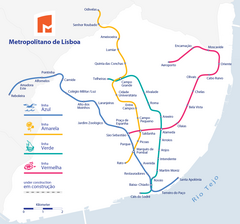Lisbon Metro
 |
|||
| Overview | |||
|---|---|---|---|
| Native name | Metropolitano de Lisboa | ||
| Owner | Government-owned corporation | ||
| Locale | Lisbon-Amadora-Odivelas, Portugal | ||
| Transit type | Rapid transit | ||
| Number of lines | 4 | ||
| Number of stations | 56 | ||
| Daily ridership | 422,000 (2012 daily average) | ||
| Annual ridership | 154 million (2012) | ||
| Website | www |
||
| Operation | |||
| Began operation | 29 December 1959 | ||
| Operator(s) | Metropolitano de Lisboa, EPE | ||
| Number of vehicles | 113 3-car trainsets | ||
| Headway | Peak hours: 4–5 minutes Off-peak: 5–8 minutes |
||
| Technical | |||
| System length | 43.8 km (27.2 mi) | ||
| Track gauge | 1,435 mm (4 ft 8 1⁄2 in) standard gauge | ||
| Electrification | 750 V DC third rail | ||
| Top speed | 72 km/h (45 mph) | ||
|
|||
The Lisbon Metro (Portuguese: Metropolitano de Lisboa) is the metro (subway) system of Lisbon, Portugal. Opened in December 1959, it was the first subway system in Portugal. As of 2012[update], the four Lisbon metro lines total 43.2 kilometres (26.8 mi) of route and serve 55 stations.
Since 1888 the thought of building a system of underground railways was present in the city of Lisbon. The idea was proposed by Henrique de Lima e Cunha, a military engineer who had published a proposal in the journal Obras Públicas e Minas (Public Works and Mines) for a network with several lines that could serve the Portuguese capital. Concrete plans took longer to form: Lanoel Aussenac d'Abel and Abel Coelho presented theirs in 1923, and José Manteca Roger/Juan Luque Argenti theirs one year later, in 1924. None of these plans were carried out.
After World War II, in which Portugal remained neutral, the national economy took off and the financial possibilities provided by the Marshall Plan gave a strong boost to the potential construction of a metro in Lisbon. A society was formed on January 26, 1948, which aimed to study the technical and economic feasibility of an underground public transportation system for Lisbon.
Construction began on August 7, 1955, and four years later, on December 29, 1959, the Lisbon Metro was inaugurated. The network was formed by a Y-shaped line linking Restauradores to Rotunda (now Marquês de Pombal), branching then to Entre Campos and to Sete Rios (now Jardim Zoológico), where the rolling stock depot (PMO I) which was also linked to the outer-loop Cintura Line of CP was located.
...
Wikipedia

